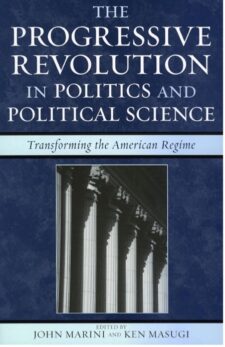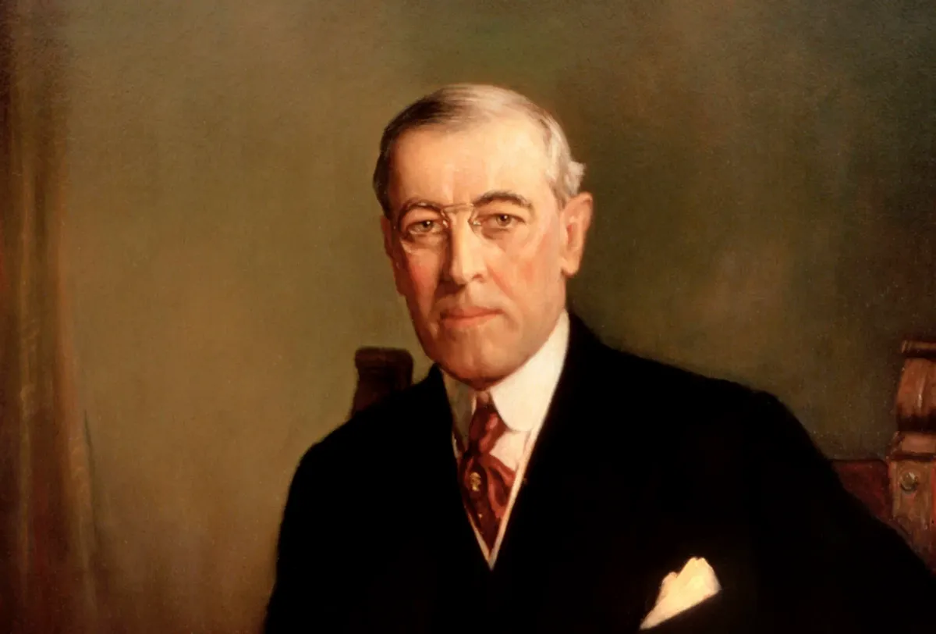Progressivism “certainly came to dominate the first modern foundations, the universities, journalism, and most other institutions of American intellectual life. But … it nonetheless failed in its effort to change entirely the way everyday American political life plays itself out.”
This coming Saturday, as The Atlantic’s David Frum has noted, it will have been 100 years since the death of President Woodrow Wilson—a leader of the Progressive movement in America. The below comments were offered by co-editor William A. Schambra at The Heritage Foundation in 2007 as part of an event on “The Progressive Movement and the Transformation of American Politics.” The event stemmed from publication of The Progressive Revolution in Politics and Political Science: Transforming the American Regime—a contributor to which, Thomas G. West, delivered remarks prior to Schambra’s comments.

***
Like the volume to which he has contributed, Tom West’s remarks reflect a pessimism about the decisively debilitating effect of Progressivism on American politics. The essayists are insufficiently self-aware—about their own contributions and those of their distinguished teachers. That is, they are not sufficiently aware that they themselves are part of an increasingly vibrant and aggressive movement to recover the Founders’ constitutionalism—a movement that could only have been dreamt of when I entered graduate school in the early ’70s.
To be sure, the Progressive project accurately described herein did indeed seize and come to control major segments of American cultural and political life. It certainly came to dominate the first modern foundations, the universities, journalism, and most other institutions of American intellectual life. But, as Mr. West suggests, it nonetheless failed in its effort to change entirely the way everyday American political life plays itself out.
As much as the Progressives succeeded in challenging the intellectual underpinnings of the American constitutional system, they nonetheless faced the difficulty that the system itself—the large commercial republic and a separation of powers, reflecting and cultivating individual self-interest and ambition—remained in place. As their early modern designers hoped and predicted, these institutions continued to generate a certain kind of political behavior in accord with presuppositions of the Founders even as Progressive elites continued for the past 100 years to denounce that behavior as self-centered, materialistic, and insufficiently community-minded and public-spirited.
The Progressive foothold
The Progressive system managed to gain a foothold in American politics only when it made major compromises with the Founders’ constitutionalism. The best example is the Social Security system: Had the Progressives managed to install a “pure,” community-minded system, it would have been an altruistic transfer of wealth from the rich to the vulnerable aged in the name of preserving the sense of national oneness or national community. It would have reflected the enduring Progressive conviction that we’re all in this together—all part of one national family, as former New York Governor Mario Cuomo once put it.
Indeed, modern liberals do often defend Social Security in those terms. But in fact, FDR knew the American political system well enough to rely on other than altruistic impulses to preserve Social Security past the New Deal. The fact that it’s based on the myth of individual accounts—the myth that Social Security is only returning to me what I put in—is what has made this part of the 20thcentury’s liberal project almost completely unassailable politically. As FDR intended, Social Security endures because it draws as much on self-interested individualism as on self-forgetting community-mindedness.
As this illustrates, the New Deal, for all its Progressive roots, is in some sense less purely Progressive than LBJ’s Great Society. In the Great Society, we had more explicit and direct an application of the Progressive commitment to rule by social science experts, largely unmitigated initially by political considerations.
That was precisely Daniel Patrick Moynihan’s insight in Maximum Feasible Misunderstanding. Almost overnight, an obscure, untested academic theory about the cause of juvenile delinquency—namely, Richard Cloward and Lloyd Ohlin’s structure of opportunity theory—leapt from the pages of the social science journals into the laws waging a war on poverty.
Indeed, the entire point of the Great Society was to reshape the behavior of the poor—to move them off the welfare rolls by transforming their behavior according to what social sciences had taught us about such undertakings. It was explicitly a project of social engineering in the best Progressive tradition. Sober liberal friends of the Great Society would later admit that a central reason for its failure was precisely the fact that it was an expertise-driven engineering project, which had never sought the support or even the acquiescence of popular majorities.
The engineering excesses of the Great Society and the popular reaction against them meant that the 1960s were the beginning of the first serious challenge to the Progressive model for America—a challenge that the New Deal hadn’t precipitated earlier because it had carefully accommodated itself to the Founders’ political system. Certainly the New Left took aim at the Great Society’s distant, inhumane, patronizing, bureaucratic social engineering; but for our purposes, this marked as well the beginning of the modern conservative response to Progressivism, which has subsequently enjoyed some success, occupying the presidency, both houses of Congress, and perhaps soon the Supreme Court.
Curiously, for Mr. West, this is precisely the moment—he settles on the year 1965—at which Progressivism achieves near complete dominance of American politics.
Recovering the Founders’ constitutionalism
Central to the modern conservative response, I would suggest, is precisely a recovery of the Founders’ constitutionalism—serious attention to the “truth-claims” of the Declaration of Independence, the Constitution, and The Federalist Papers. This had begun in the mid-1950s but really gathered steam in the ’60s. It was above all a result, as John Marini’s essay in The Progressive Revolution in Politics and Political Science suggests, of Leo Strauss’s acknowledgement that the constitutional democracies of the West, no matter how weakened by the internal critique of Progressive elites, had alone managed to resist modern totalitarianism and were worthy of a spirited intellectual defense.
Suddenly, the founding documents, which had long been consigned to the dustbin of history, came once again to be studied seriously, not as reflection of some passing historical moment of the late 18th century, but rather as potential sources of truth about politics, government, and human nature. Harry Jaffa, Herbert Storing, Martin Diamond, Harry Clor, Allan Bloom, Irving Kristol, and so forth all devoted at least some of their efforts to serious study of the Founders’ thought—a process that the volume before us continues.
I would argue that linking the conservative resurgence to a recovery of the Constitution was in fact a critical part of its ability to flourish in a way that conservatism had not otherwise managed earlier in the 20th century.
- Attention to constitutionalism sustained conservatism’s appreciation for the central place of individual liberty in American political life, but now tempered by other principles that prevent it from flying off to the extremes of libertarianism, with its rather abstract theoretical commitment to individual liberty to the exclusion of all else.
- The constitutional idea of equality helped us resist the liberal shift from equality of opportunity to equality of results, but it also severed the new conservatism from past versions of itself which had unhappily emphasized class, status, and hierarchy—notions which had never taken hold in America.
- Attention to the concept of the commercial republic shored up the idea of free markets but without relapsing into a simplistic worship of the marketplace, given Hamilton’s view of the need for an active federal government in creating and preserving a large national common market.
- Speaking of Hamilton, his essays in The Federalist suggesting the need for a powerful executive branch that would lead America into a position of international prominence sustained conservatism’s new understanding of America’s role in the world, severing it from the isolationism that had previously marred conservative doctrine.
- Finally, a recovery of the Constitution’s concept of decentralist federalism informed conservatism’s defense of family, neighborhood, local community, and local house of worship; that is, it gave us a way to defend local community against Progressivism’s doctrine of national community but within a strong national framework, without falling into anarchic doctrines of “township sovereignty” or concurrent majorities.
In other words, to some degree, modern conservatism owes its success to a recovery of and an effort to root itself in the Founders’ constitutionalism. Frank Meyer was famous for his doctrine of fusionism—a fusing of libertarian individualism with religious traditionalism. The real fusionism for contemporary conservatism, I would suggest, is supplied by its effort to recover the Founders’ constitutionalism, which was itself an effort to fuse or blend critical American political principles like liberty and equality, competent governance and majority rule.
As noted, the Founders’ constitutionalism had continued to shape American politics and public opinion in a subterranean fashion throughout the 20th century out of sight of, and in defiance of, the intellectual doctrines and utopian expectations of American Progressive intellectuals. Modern conservatism “re-theorizes,” so to speak, the constitutional substructure and creates a political movement that, unlike Progressivism, is sailing with rather than against the prevailing winds of American political life. That surely makes for smoother sailing.
Mr. West and his co-authors are all children of this conservative resurgence and are themselves obviously hoping to link it to a recovery of constitutionalism. So perhaps it is just modesty that leads them to profess that their efforts and those of their teachers have come to naught and to insist that Progressivism has succeeded in destroying America after all.
The early constitutionalists
This volume’s pessimism also neglects the critical moment in American history which provided the indispensable basis for today’s effort to recover the Founders’ constitutionalism. As you may know, in the Republican primaries of 1912, Theodore Roosevelt campaigned for the presidency on a platform of radical constitutional reform enunciated in his “Charter of Democracy” speech, delivered in Columbus in February 1912. There and subsequently, he endorsed the full range of Progressive constitutional reforms: the initiative, referendum, and recall, including the recall of judges and judicial decisions.
Had Roosevelt managed to win the nomination of his party as he came close to doing, it is likely that it would have put its weight behind these reforms and others that appeared later in the platform of the Progressive Party, including, critically, a more expeditious method of amending the Constitution. That would probably have meant amendment by a majority of the popular vote in a majority of the states, as Robert La Follette suggested. Had that happened—had the Constitution come down to us today amended and re-amended, burdened with all the quick fixes and gimmicks that, at one point or another over the 20th century, captured fleeting majorities—the effort to recover the Founders’ constitutionalism and reorient American politics toward it would obviously have been a much, much trickier proposition.
This is precisely what William Howard Taft, Henry Cabot Lodge, Elihu Root, and other conservatives understood. So they stood against Roosevelt, in spite of deep friendships and in spite of the certainty of splitting the party and losing the election. For they believed that the preservation of the Constitution as it came to them from the Founders had to be their first priority, and they believed that this question would be settled decisively in the Taft-Roosevelt contest of 1912. When the constitutionalists succeeded in keeping the magnificent electoral machinery of the Republican Party out of Roosevelt’s hands, they were able to tell themselves that they had done the one thing needful.
And they were right, I would argue. In spite of the fact that Progressivism would go on to seize the commanding intellectual heights of the past century—in spite of the fact that law schools, political science departments, high-brow journals, and foundations alike told us to transcend and forget about the Founders’ Constitution—it was still there beneath it all, still there largely intact, waiting for rediscovery, still the official charter of the Republic, no matter how abused and ridiculed.
This aspect of the election of 1912—that is, the contest within the Republican Party between Taft and Roosevelt about preserving the Constitution—is almost entirely forgotten today. Shelves and shelves of dissertations and books have been done on Progressivism and socialism in that election, but virtually nothing about conservatism. As we try to recover an understanding of the Founders’ Constitution, so also conservatives need to recover our own history, which has otherwise been completely ignored by the Progressive academy.
Anyway, let us not neglect the sacrificial struggles of men like Root, Taft, and Lodge in seeing to it that we have a constitutional tradition to recover—or, rather, seeing to it that the recovery is worthwhile, because the written Constitution has come down to us largely as it emerged from the pens of the Founders and still commands popular allegiance.




